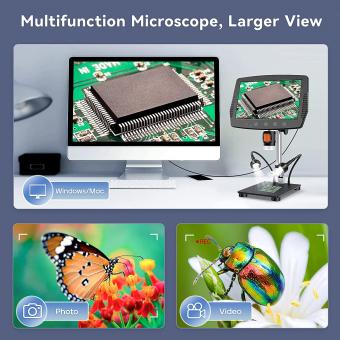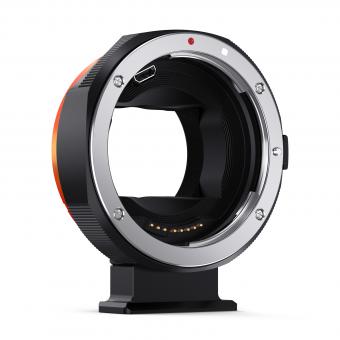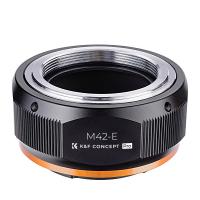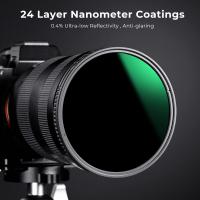Can You See Atoms With Electron Microscope ?
Yes, electron microscopes are capable of imaging atoms. This is because they use a beam of electrons instead of light to create an image, which has a much shorter wavelength than visible light. This allows them to achieve much higher resolution than optical microscopes, which are limited by the wavelength of light. With an electron microscope, it is possible to see individual atoms and even the arrangement of atoms within a molecule. This has been a major breakthrough in the field of materials science, allowing researchers to study the properties of materials at the atomic level.
1、 Atomic Structure

Yes, electron microscopes can see atoms. In fact, electron microscopes are the only type of microscope that can directly observe atoms. This is because electrons have a much shorter wavelength than visible light, allowing them to interact with and "see" much smaller objects.
In the past, scientists used transmission electron microscopes (TEMs) to observe atoms. These microscopes use a beam of electrons that passes through a thin sample, creating an image of the atoms on a screen. However, this method had limitations, as the sample had to be extremely thin and the electrons could damage the sample.
More recently, a new type of electron microscope called the scanning transmission electron microscope (STEM) has been developed. This microscope uses a focused beam of electrons to scan across a sample, creating a highly detailed image of the atoms. The STEM can also be used to analyze the chemical composition of the sample, providing even more information about the atomic structure.
However, even with the advanced technology of electron microscopes, there are still limitations to what can be observed. Atoms are constantly moving and vibrating, making it difficult to capture a clear image. Additionally, electron microscopes can only observe the surface of a sample, so the internal structure of a material cannot be directly observed. Nonetheless, electron microscopes have revolutionized our understanding of atomic structure and continue to be an important tool in scientific research.
2、 Electron Microscopy

Electron microscopy is a powerful tool that uses a beam of electrons to produce high-resolution images of a sample. It has revolutionized our understanding of the microscopic world, allowing us to see structures and details that were previously invisible. However, the question of whether we can see atoms with an electron microscope is a bit more complicated.
In theory, an electron microscope should be able to see individual atoms. The wavelength of electrons is much smaller than that of visible light, which means that electron microscopes have much higher resolution than optical microscopes. However, in practice, there are several factors that limit our ability to see atoms with an electron microscope.
One of the main limitations is the sample itself. In order to see individual atoms, the sample must be thin enough to allow electrons to pass through. This is not always possible, especially for complex materials like biological samples or materials with a high atomic number. Additionally, the electrons used in electron microscopy can damage the sample, which can make it difficult to obtain high-resolution images.
Despite these limitations, there have been several recent advances in electron microscopy that have allowed us to see individual atoms in certain materials. For example, aberration-corrected electron microscopy has greatly improved the resolution of electron microscopes, allowing us to see individual atoms in materials like graphene and silicon. Additionally, cryo-electron microscopy has allowed us to study biological samples at high resolution without damaging them.
In conclusion, while it is theoretically possible to see atoms with an electron microscope, there are several practical limitations that make it difficult. However, recent advances in electron microscopy have greatly improved our ability to see individual atoms in certain materials, and it is likely that further advances will continue to push the limits of what we can see with this powerful tool.
3、 Resolution Limits

The electron microscope is a powerful tool that uses a beam of electrons to produce high-resolution images of samples. However, the question of whether atoms can be seen with an electron microscope is a complex one that depends on several factors, including the resolution limits of the microscope.
The resolution limit of an electron microscope is determined by the wavelength of the electrons used to image the sample. According to the laws of physics, the resolution limit of any microscope is equal to half the wavelength of the radiation used to image the sample. For electron microscopes, the wavelength of the electrons is much smaller than that of visible light, which allows for much higher resolution imaging.
However, even with the high resolution of electron microscopes, it is still not possible to directly see individual atoms. This is because the size of an atom is much smaller than the resolution limit of the microscope. Instead, electron microscopes are used to indirectly observe the behavior of atoms and molecules by imaging their interactions with the electron beam.
Recent advances in electron microscopy, such as aberration correction and cryogenic imaging, have pushed the resolution limits of electron microscopes to the point where individual atoms can be resolved in some cases. However, this requires specialized equipment and techniques, and is still not possible in all cases.
In summary, while electron microscopes are powerful tools for imaging samples at high resolution, it is still not possible to directly see individual atoms with them. However, recent advances in electron microscopy have pushed the resolution limits to the point where individual atoms can be resolved in some cases.
4、 Sample Preparation

Sample preparation is a crucial step in electron microscopy, as it determines the quality and resolution of the final image. While electron microscopes are capable of producing high-resolution images of small structures, such as atoms, the question of whether atoms can be seen with an electron microscope is a complex one.
Electron microscopes use a beam of electrons to illuminate a sample, which then interacts with the electrons to produce an image. The resolution of the image is determined by the wavelength of the electrons, which is much smaller than that of visible light. This allows electron microscopes to produce images with much higher resolution than optical microscopes.
However, the ability to see atoms with an electron microscope depends on several factors, including the type of sample, the quality of the microscope, and the imaging technique used. In general, it is difficult to directly image individual atoms with an electron microscope, as they are too small and their interactions with the electron beam can be complex.
Recent advances in electron microscopy, such as aberration correction and cryogenic sample preparation, have improved the resolution and quality of electron microscope images. These techniques have allowed researchers to image individual atoms in some materials, such as graphene and certain types of crystals.
In summary, while it is difficult to directly see individual atoms with an electron microscope, recent advances in sample preparation and imaging techniques have improved the resolution and quality of electron microscope images, allowing researchers to image individual atoms in some materials.








































